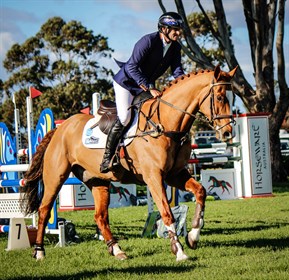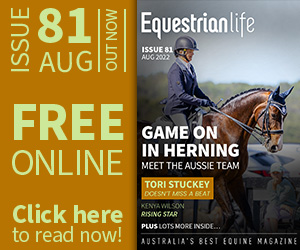
This article has appeared previously with Equestrian Life. To see what is in the latest issue of the digital magazine, please click here.
Stuart Tinney and Celebration.
© EQ Life
Showjumping tips with Stuart Tinney
Stuart talks us through the showjumping phase of a one-day event (ODE) from his position as a rider on an inexperienced young horse.
By Stuart Tinney
First of all, please don’t get stressed if you have a rough ride, or you have some mishaps it is all part of being a horse rider. I have mishaps too - but we won’t discuss them today!
Normally at a ODE there will be a schedule that will give you your approximate time to do the phase you are about to ride. The Showjumping times will often just give you a time that your particular class will be held, i.e. Prelim course walk at 9 am and the class will commence at 9.15 am numerical order. My advice is to keep your eye on the course and make sure that you are around and fully attired for Showjumping phase as to not miss the course walk. Ask your coach if they have time to walk the course with you, it is very daunting doing it by yourself if you are inexperienced. Remember that often you and others are doing your first ODE and so too are the horses. I am hoping that you will have some idea of your distances and that you have been taught the strides between related lines and doubles. You certainly will know if you have an accredited coach.
So here I am going into the last phase of the day and the jumps have been set by the designer and I see spooky fences, lots of fill, no ground lines, three related distances and one double. There is no doubt that once in the ring anything can happen. And all those jumps will come up much faster than anticipated.
So the first part is to walk the course so I have some idea of distances, and make a plan in my head of the strides I will do for the related lines, the turns and approach lines that I will take. Know the time on course, which will be on the course plan posted at the entrance to the arena. Your aim is to obtain no time penalties but at this stage it is better to produce a nice flowing round giving the horse plenty of room for approach to fences and giving them a confident experience.
I am happy with the walk and have organised that my mare will be all ready to mount, with the correct saddle for jumping, plus open fronted boots and closed or open hind boots depending on what I desire for the day. Often the grass can be slippery if it is on firm ground, so studs may be necessary. I will warm my mare up for a short time as she has had a big weekend and has produced some great work, so there is no need to overdo her. I will start with a cross rail and then perhaps a small vertical then an oxer. I don’t jump too many jumps but sometimes jump on an angle to sharpen her eye to the rails before I go in. Amy, my groom is always there for us and she knows exactly what I like for each horse, so if you have your Coach handy that will really help with your warm up and confidence.
Watch the course ride, especially watch the good riders, it will give you an idea on the distances, the turns, lines and approaches to fences they take and the time. When I enter the ring, I proceed firstly to the judge’s box and introduce myself and the horse. The bell normally rings straight away and it is very important that you don’t go through the start until you are belled to start.
As predicted my mare thought the first fence was just so spooky and so a lot of leg was needed for encouragement but once over the first she was well and truly locked onto the next four fences. The fifth fence was at the in-gate and there was quite a bulge in the line towards the gate which is normal behavior for a green young horse. She was just super until she had to concentrate on a four stride related line to the double jumping towards the spectators. I just felt her look towards the crowd and take her eye off the front rail of the double. Luckily only a rattle of the rail, but she certainly needs to go out jumping more often!
I must admit jumping the young green ones takes a lot of concentration on my part, I love my horses when they are not so green and I can be more of a technician as opposed to a trainer!
READ THE LATEST NEWS ARTICLES HERE
https://www.equestrianlife.com.au/articles/Showjump-training-with-Stuart-Tinney

